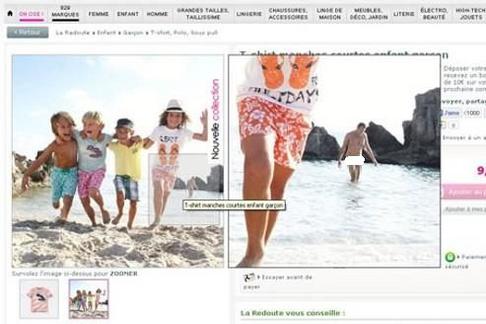For French fashion retailer, La Redoute, 2012 certainly started with a bang–or should I say, wang? The French company published this photo promoting its children’s clothing line on its website. It lasted 16 hours before it was taken down.
If you haven’t figured it out yet, one of these is not like the others. And the elephant-in-the-pond is wading bottom right. From a distance, the nudist may not be noticeable, but upon scrolling the image to zoom in on the kid’s beachwear, the man’s genitals are visible for all to see.
Obviously, this caused quite the stir. And the company issued apologies using social media outlets, Twitter and Facebook.
However, it had many people wondering whether this was a genuine mistake or a marketing ploy. Perhaps, it was the former–an accidental oversight by France’s largest mail order company and somehow its team of photographers, editors, web managers & marketers didn’t see it. But I’m guessing the 5th model here, while clearly advocating the liberal French attitude, was not your case of Oops-we-forgot-to-edit-out-the-nude-guy-in-the-background. It may be coincidental that La Redoute’s advertising campaign is “everything is allowed.”
Unfortunately, for La Redoute, the extra publicity for its site has also brought on opportunities for the competition. It’s top competitor, 3 Suisses, quickly jumped at the chance to exploit the blunder with a slightly modified, yet much more modest image for their own campaign. It shows the nudist wearing beachwear from their clothing line with the caption,
“Obviously everyone does not know that we have swimsuits from €9.99″.
While La Redoute’s true motives are questionable, sometimes fashion companies do employ intentionally controversial campaigns to drive brand awareness. United Colors of Bennetton, known for their controversial publicity strategies, caused just a little uproar with their latest “Unhate” campaign two months ago.
It features images of world leaders kissing (their alleged nemeses). Perhaps the most troublesome fake photo was that of Pope Benedict XVI in a stern lip-lock with the Sheik Ahmed el-Tayeb, the prominent figure for Sunni Islams in Egypt.
This image lasted on the company’s website for less than a day before the Vatican threatened to take legal action.
Another image from the campaign shows US President Obama embracing Venezuela’s Hugo Chavez.
While the White House had strong disdain for these photos, they stopped just short of taking legal action.
According to the Huffington Post, Benetton said the photos of political and religious leaders kissing were “symbolic images of reconciliation – with a touch of ironic hope and constructive provocation – to stimulate reflection on how politics, faith and ideas, when they are divergent and mutually opposed, must still lead to dialogue and mediation.”
But sometimes ads get pulled for less shocking controversies, as in the case of Taylor Swift’s eyelash-gate with CoverGirl.
The ad was pulled after it was deemed false advertising by an advertising watchdog organization.
The ad, featuring the singer with (overly) plump eyelashes includes, in small print at the bottom, “Lashes enhanced in post production.”
But whether or not an advertisement is misleading, controversial, or in poor taste– is an issue that has been around since the dawn of advertising.
Here are some of the best of the worst advertising blunders–as far back as 1966. Enjoy:)
Who: Pepsi
When: 2011
Pepsi thought it would be all the rave to unveil a new “slim, stylish can” during New York’s Fashion Week last year. Unfortunately, a little group called the National Eating Disorder Association, didn’t like the not-so-subtle message of: Its In to be Thin.
Who: McDonald’s
When: 2005
This little company decided they wanted to appeal to a younger, much hipper crowd–since they obviously lack that target audience. Long story short, the McMarketing team obviously didn’t understand the dialect of slang they were using because all I see is a young man who wants to de-bun that burger.
Who: Jones Soda
When: 2004
In attempt to broaden their consumer audience, Jones’ decided to create new flavors, and naturally, skipped market research in favor of…farms? With new flavors such as dirt & ham, you have to wonder why this campaign didn’t become more fertile.
Who: Nike
When: 2000
“Why Sport?” asks the clever fitness brand. Apparently, when you’re getting chased by a crazed masked-man with a chainsaw, “You’ll live longer.” Check out the Nike video and see if you can understand why Nike “Just did it” then undid it.
Who: Calvin Klein
When: 1995
Although the marketing attempt wasn’t exactly a success in the advertising world (or with the parents of aimed consumers), this clothing company kind of made a point with “sex sells” in their 1995 campaign that featured barely legal & barely clothed models being interviewed by an unseen creepy old man in what appeared to be an amateur porn video. For the most part, people hated it and CK pulled the ads in under 24 hours.
Who: The Beatles
When: 1966
Apparently, the Fab Four wanted to break away from their cookie-cutter image and do something more artistically creative by donning broken baby doll parts and raw meat in what is now known as the “Butcher cover.” Unfortunately, not many people seemed to like the message, whatever it was. In the end, it was actually the only Beatles’ album to lose money. (But today one of these rare albums can actually go for as much as $30,000).


